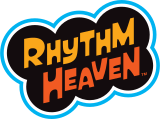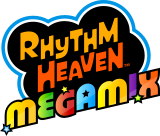Rhythm Tengoku/Arcade
JP Room
| CERO: |
Rhythm Tengoku
Rhythm Heaven
Rhythm Tengoku (リズム天国?, Rhythm Tengoku) is an arcade port of Rhythm Tengoku for the Game Boy Advance. It was developed by Nintendo and published by SEGA. It was released on September 20, 2007 in Japan.
History
SEGA approached the development team with an offer for an arcade version as the game was popular with SEGA staff. Osawa and Ko Takeuchi, who initialy thought it was a joke, were impressed, as they never thought Rhythm Tengoku was able to gain a following.[1]
Gameplay
Players start the game with two hearts. Each heart is lost when starting a Rhythm Game. Getting a Superb or Perfect gives an extra heart, as well as close the game for the rest of the Stage. If the player runs out of hearts, they will need to spend a credit to continue (or, depending on the machine's settings, multiple credits, or none if set to Freemode). The player needs to clear all five games and the Remix in the Stage with at least an OK to move on. Depending on the settings, the Remix may be unselectable, requiring the player to clear all the games in order to play it.
Rhythm Games
All of the Rhythm Games from Rhythm Tengoku are available in the 1 Player (1人で遊ぶ?, 1-Ri de Asobu) mode. The arcade version has an Extra stage as well. A selection of games are also present in the 2 Player mode.
1 Player
|
1人で遊ぶ |
2 Player
|
2人で遊ぶ |
Differences
- Rhythm-kan Sokutei, Rhythm Shiryo Shitsu, Studio, Café, Rhythm Toys, Endless Games, Drum Lessons, Staff Credits, and Live are all absent from this version. Most of the music unique from them has been repurposed for new features in this version.
- Neko Machine and Kokuhaku Machine can be seen in the attract mode instead. The latter can also be interacted with.
- The Drum Girls make a cameo on the Player Mode menu.
- If the player enters the game's Service Mode, they can change several settings, including the number of hearts they start off with, how many coins need to be inserted for a credit (Freeplay is also available) and if the Remix is open from the start or not.
- The games Spaceball, Iai Giri, Sick Beats, Bunny Hop, Night Walk and Polyrhythm now have tutorials unlike the original. Bouncy Road also has a tutorial in addition to it's practice. All 2P games have tutorials as well.
- The player doesn't receive a Try Again for getting a question wrong in the practice of Quiz Show. The game simply moves on to the next question instead.
- Ninja Bodyguard uses Left and Right on the D-pad, instead of D-pad and A. The arrows above the ninja are changed accordingly.
- If the player has played perfectly for the first half of a Rhythm Game, the "Go for a Perfect!" notice will appear on the bottom of the screen. Obtaining it does the same as getting a Superb however.
- The game has a leaderboard feature, tallying up the score based on the player's flow at the end of a stage.
- The resolution is larger, and the graphics are manually upscaled to appear smoother. Most non-gameplay graphics are higher quality as well.
Gallery
Regardless of whether or not the player gets a high score, they will always see this screen, with the Girl telling them to try the next stage.
Trivia
- This is one of the very few games developed by Nintendo and SEGA.
- This was playable in Hyper Japan 2016 in London.
- This is the first game in the series to have a Two Player mode.
- Although, the first multiplayer game in the main series would be Rhythm Heaven Fever.
External Links
References
| Rhythm Tengoku (GBA/Arcade) | ||
|---|---|---|
| Rhythm Games | Omake Corner | |
| STAGE 1 | ||
| STAGE 2 | ||
| STAGE 3 | ||
| STAGE 4 | ||
| STAGE 5 | ||
| Revival | ||
| Technician | ||
| Last Technician | ||
| Arcade Only (1P) | Extra | |
| Arcade Only (2P) | STAGE 1 | |
| STAGE 2 | ||
| STAGE 3 | ||
| STAGE 4 | ||
| STAGE 5 | ||
| Extra | ||
| Rhythm Omocha | ||
| Endless Games | ||
| Miscellaneous | ||
| Rhythm Heaven Series | |||
|---|---|---|---|

|

|

|

|
| 2006, GBA • 2007, Arcade | 2008-2009, DS | 2011-2012, Wii • 2016, Wii U | 2015-2016, 3DS |

















